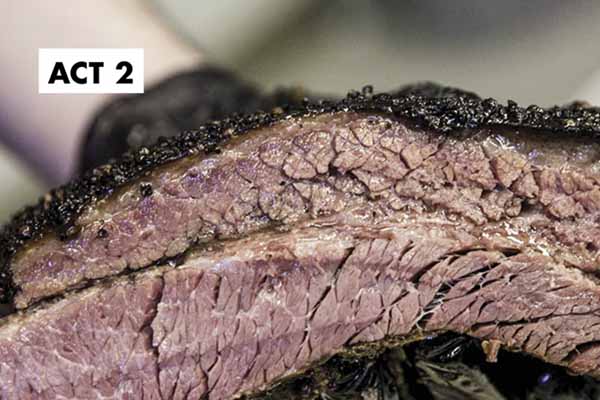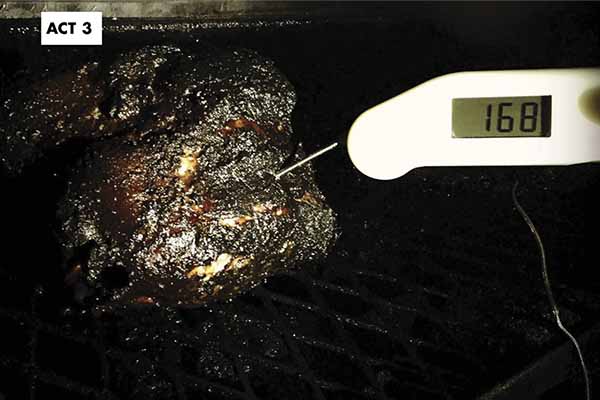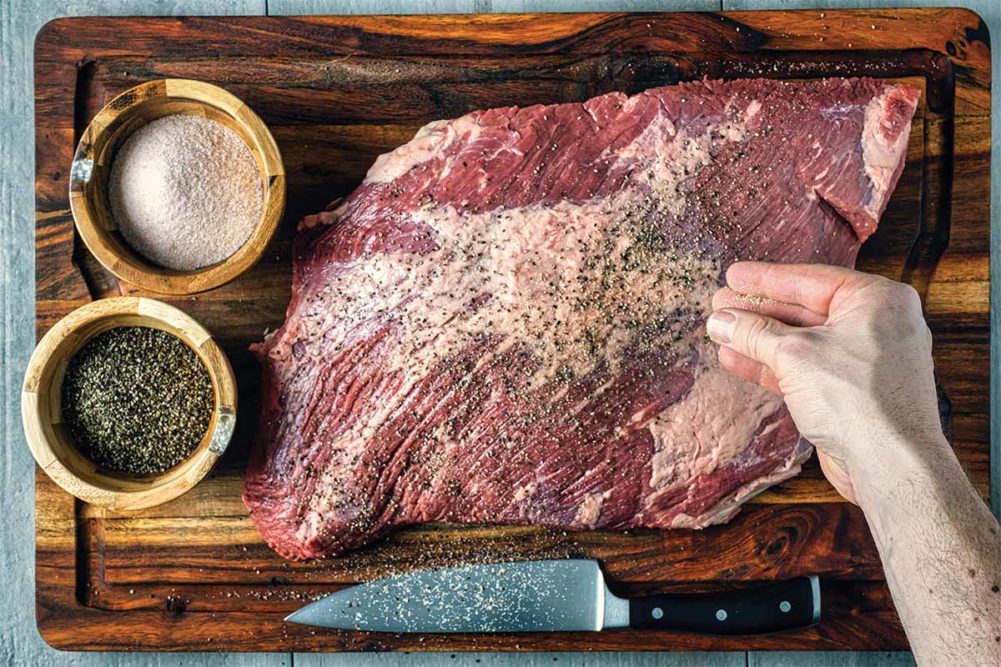Playwrights use the three-act structure to present stories that when well-crafted ensure a positive response from the audience. While there are many variations of the three-act structure, one outlined by Kindlepreneur offers a glimpse into a basic approach — Act I: Setup; Act II: Confrontation; and Act III: Resolution. Although designed for performing arts, this three-act concept can be applied to preparing barbecued meats.
Barbecuing is a multistep production. It requires the right set-up (meat, seasonings, fuel, and smoke), appropriate action (cooking), and resolution (resting before serving) to all come together to deliver products that the preparer desires and the consumers expect.
Act I: Set-up
Our entrance to the world of barbecue began in 2009 with ANSC 117, Texas Barbecue, a class for freshmen at Texas A&M University, which was followed by our first collaborative workshops with Foodways Texas — Barbecue Summer Camp (2011) and Camp Brisket (2013). We have been both instructors, providing scientific and technical aspects of preparing barbecue, and students, learning from the professionals who do this for a living. There may not be an exact formula for barbecue perfection, but these key points improve the odds of success.
Selecting beef is not as easy, and for brisket, quality is important. At Camp Brisket, taste test comparisons often reveal US Prime and Japanese Black Wagyu brands rate higher than those from lower quality grades. Informal surveys of the top Texas barbecue establishments reveal that most of them use US Prime or branded beef products with upper marbling levels. The availability of US Prime briskets in the marketplace is common, so those who wish to cook high-quality beef have that option.
Seasonings - The wide array of available seasonings can be quite confusing. Cooking shows, books, and online recipes tempt consumers to try the latest seasoning trend. Our message to the freshmen in Texas Barbecue is this: seasonings should complement, not cover up, the basic meat flavors. In the end, using only salt and pepper adds wonderful flavors.
Another key point to remember is that leaner meats such as pork and poultry may require more seasoning, whereas beef with an initial richer flavor needs less. Discovering what works best for the products being cooked and for the taste preferences of the consumers requires practice before being ready for show time.
Equipment - Whether for the backyard enthusiast or commercial operator, no topic evokes more controversy than does what smoker or cooker is best. Equipment prices range from hundreds to tens of thousands of dollars, and the features of each one can be debated as to why they are superior to others. Like other products that come and go, different brands and types of smokers/cookers gain popularity for a while, and then others take their place.
The variety of equipment available is staggering. Offset and traditional, reverse flow, rotisserie, kettle, kamado and egg-style, and pellet are some of the smoker options. Selecting one often depends on personal preference and budget, but great barbecue can be made with each of them.
Fuel and smoke - Barbecue requires heat for cooking and smoke for flavor. Some cookers use hardwood to produce both heat and smoke. Commonly used woods are hickory, oak, pecan, and mesquite, along with some fruit woods such as apple, cherry, and peach. Forms of charcoal include chunks and briquettes, and pellets are available in many different wood species.
The importance of a clean fire and clear smoke cannot be overestimated. Wood must be properly seasoned so that it is dry before burning, and the use of petroleum starters should be minimized or avoided to reduce chemical tastes. To provide great tasting products without an aftertaste, the fire should be started long before placing the meat in the cooker/smoker.
 Source: Kelly Yandell
Source: Kelly Yandell
Act II: Confrontation
Act I is complete. It is time to move to Act II, where the magic of barbecue takes place.
Cooking - For most, the term “low and slow” is what comes to mind when cooking barbecue. We want low temperatures (approximately 250°F) for long periods (6 to 14 hours, depending on the size of the cut). This ensures the exterior of these large cuts does not overcook, and that the interior reaches the desired internal temperatures.
Cooking begins to denature the proteins and render the fat. The muscle fiber proteins start to unwind. The connective tissue in proteins, especially in the pork shoulders and briskets that contain higher concentrations of them, must be converted into gelatin. This requires higher temperatures and is why internal temperatures for some of these cuts reach approximately 200°F before they are deemed finished. Professional pitmasters often use softness and feel as their gauge for knowing when products are cooked.
Protein denaturation and fat rendering is not all that occurs. The Maillard Reaction, or the browning reaction, along with the interaction of the smoke and seasonings, combine to create unique flavors. This is where the magic of barbecue occurs. Like some characters in a play, connective tissue and fat that we first thought to be bad transform during cooking creating succulent flavors and mouthwatering goodness that we expect in barbecue.
 Source: Jeff Savell, Texas A&M University
Source: Jeff Savell, Texas A&M University
Act III: Resolution
Act III is also known as the “denouement,” which means that “the strands of the plot are drawn together, and matters are explained or resolved.” One of the greatest learnings from years of working with barbecue pitmasters is the importance of allowing products to properly rest before serving. Omitting the holding step and serving too soon after cooking is why many struggle with preparing great barbecue.
Resting - In cooking, resting is where products are removed from the heat source and allowed to equilibrate before slicing and serving. The moisture in the meat is still being acted on by the residual heat and needs time to equilibrate. When barbecuing large cuts of meat, the time necessary for this equilibration is much longer. If the internal temperature of these cuts is around 200°F at the end of cooking, then the time for resting is quite long, and the meat should be in the range of 140°F to 150°F before slicing and serving. Resting is not measured in minutes but hours. One recommendation is to prepare the products for the meal before you want to serve it: for example, if for dinner, aim for a lunch completion.
Holding - From a food safety aspect and to prevent outgrowth of Clostridium perfringens spores, the holding temperatures should be 140°F or higher, which are the hot holding requirements in FDA’s Food Code. Some restaurants use electric food warmers to hold cooked products until serving time.
Curtain call - In the end, the cost, time and commitment to preparing wonderful barbecue requires consideration of many factors. Following some of these key points may result in a richly deserved standing ovation from “encore”-chanting dining guests.


